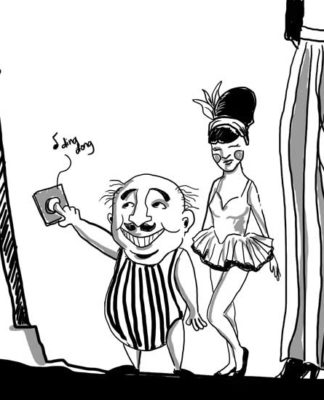THROUGH a unique visual presentation of the human’s flesh, a travelling exhibit showcases real human specimens preserved under room temperature, made possible by the process of ‘plastination’.
Dr. Gunther Von Hagens, a German anatomist and inventor of the plastination, believed that he can make a human sample without storing them in freezing temperatures.
“Specimens were permanently preserved, retaining the texture of the skin tissues, even its microscopic capillaries, as if they were alive,” said exhibit marketing manager Rosse Gamban.
The exhibition, located in Taguig city, was divided into halls named after Greek deities, which represents each of the human body’s system.
Discovering the human body
During the ancient Greek times, people believed that each god signified a part of our body. Each of these gods contributed to the formation of the human.
In the Myth of the Human Body, different halls named after these deities introduced these significant body parts. However, the Body was not really formatted to a Greek-inspired theme.
“The exhibit was not actually Greek -inspired,” said Gamban. “It just happened that the building where it was going to be held had a Greek motif, so the exhibitors decided to relate the exhibit to Greek gods to give the exhibit an artistic flavor.”
According to Gamban, most Body museums in the world were held in warehouses.
“It (warehouses) make it (the exhibit) less interesting and associating the exhibit to Greek gods was a welcoming change,” she added.
With the company of a tour guide, a brief explanation was given to further understand the displayed specimens.
Plastination was explained for the tourists to know the history of how the bodies were preserved.
The next hall was Hercules’, which showcased the skeleton and muscular system of the body. In this hall, the Runner Man, a full-body specimen, featured the shapes of the muscle and the inner skeleton of the human body.
Composing 1/5 of the whole body weight, the skeletal structure of a human maintains the body shape and protects the internal organs.
Following the Hercules Hall was Poseidon’s, which embodied the respiratory system. Poseidon, the god of the sea, has the ability to breathe underwater. This symbolizes the respiratory organs.
One body specimen in the Poseidon hall had a titanium knee replacement. It was said that the human body was rich in his ‘living days’ since he could afford to have his knee replaced. In China, where the body came from, only those who are wealthy can afford such surgery.
The Dionysus hall, which was also called the ‘digestion hall’, succeeded. The hall showcased the Strong Man, which displayed the different organs in the digestive system. The Strong Man was also a representation of the unequal testicles, where the normal pair of testicles weighs three grams heavier than the other.
Hades hall came next, showcasing the cardiovascular system of the human body. According to Gamban, though all of the specimens were interesting and unique, the Red Man in the Hades hall was the most fascinating.
“This specimen could be the most detailed and complex to make, for obvious reasons,” Gamban said. “As you must have noticed, the specimen is showing signs of falling apart already. To plastinate the blood vessels, it is too complex and meticulous.”
The blood vessel specimen is only available in Gunther’s collection.
The Eros hall or the reproductive system hall had the most sensitive set of specimens. Eros, the god of sexual love and beauty, represents the reproduction. Reproductive organs of male and female were shown in plastinated specimens.
To understand the essence of giving birth from the conception to delivery, a video presentation was played for the tourists.
The Zeus hall, or the nervous system, followed after the Eros hall. Displayed in this hall was the Dancing Man, which had a real preserved set of eyes.
Brains with different disorders were also shown. The tourist guide explained that intelligence is higher when the brain is more ‘depressed’ or when there are more deep lines than usual. Memory loss, on the other hand, can be acquired only if the front part of the head is hit and not the back part.
The last hall was the Artemis hall, which showcases the fetal system. The evolution of the fetus, in different stages and period, was presented in preserved bottle containers. a certain confidential chemical was also injected in the fetus to make the bones visible, making them red in color.
Real, donated bodies
Unlike other human body exhibitions, Gamban believed that the Myth of the Human Body is a diverse exhibit of bodies. She said that these human specimens were actually real donated bodies who wanted their bodies on display for educational and medical purposes.
“These donors have consented to be plastinated in the belief that they are contributing to the further study anatomy – a crucial study that will help everyone achieve a better health,” Gamban said.
Most of the displayed human bodies were Chinese. Only two human bodies from the whole set were European, which were the One-lung Man and the Muscle Man.
Gamban also wanted to invite Filipinos who have not yet witnessed the exhibition.
“For one, it is educational because you can actually see the placement of the organs in the human body,” Gamban said. “And by seeing the exhibit, Filipinos will get to understand the inner workings of their bodies.”
For those who are in the medical field, Gamban said that the exhibit will show what is beyond their medical books with the actual organ and body parts.
“There were studies that show that those who have seen this exhibit have dramatically decreased smoking and drinking, abortion, and were exercising more,” she added.
The showcase of cadavers originated in Germany, where they made five sets of the exhibit, exporting it to different countries in the world. The Southeast Asia version, which was initiated in South Korea, is the one exhibited in the Philippines. Camille Anne M. Arcilla
















It’s difficult to find knowledgeable people in this particular topic, but you seem like you know what
you’re talking about! Thanks
thank you for this post, I am a big big fan of this
site would like to go on updated.
It?s nearly impossible to find knowledgeable people for this subject, but you sound like you know what you?re talking about!
Thanks